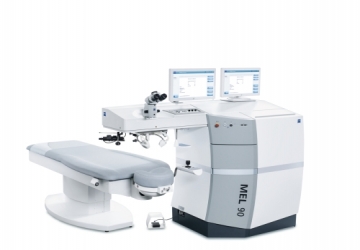
Excimer laser
It is one of the latest scientific findings in treating the refractive defects of the eye, in which low-wave ultraviolet lasers are used to modify the surface of the cornea, and thus change its refractive strength. These rays remove layers of corneal tissue with pinpoint accuracy, with precisely defined length and depth.
Dr. Muhammad Hantira, an honorary assistant professor at the ophthalmology department, Umm Al-Qura University, Saudi Arabia, explained
That during the procedure of the laser there are those who monitor the process and watch it, through a computer located within the excimer laser tasked with determining the exact amount to be removed from the corneal tissue while maintaining the survival of the tissues soft and smooth.
How the laser works
Dr. Hantira explained:
The laser device works on shedding a beam of rays on the corneal tissue to be treated, which leads to those particles being dispersed from the cornea and thus changing its refractive power. In the event that these rays are shed inside the corneal tissue, it is called LASIK, which we will discuss in detail later. In the case of shining rays on the surface of the cornea, it is a superficial treatment, which is the subject of our discussion in this chapter.
The method of performing the operation
Dr. Hantira explained:
That, after the eye is given local anesthesia, the surface cells of the cornea (Epithelium) are removed manually, and then laser beams are applied to the outer surface of the cornea.
In order to speed up the healing of the outer layer of the corneal wound, and relieve the pain that some people may feel after the operation, a soft contact lens is placed, so that this lens is removed after the wound has healed, which may take 3 to 5 days.
It is worth noting that vision begins to improve gradually during the first weeks of the operation, but the final stability of vision may take 3 to 4 months.